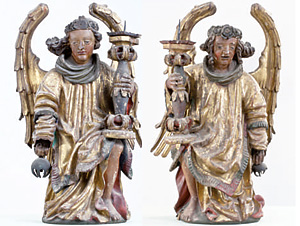Hochschularbeit
| Lisa Reischer: | Two mechanical angels from the parish and pilgrimage church of St. Wolfgang im Salzkammergut (1525/35): Examination and conservation of a late Gothic pair of sculptures | Zurück |
| Sprache: | Original - Übersetzung | |
| Seitenübersicht: |
|
|
 |
|
| Zusammenfassung: | The present thesis deals with the examination and conservation of a wooden polychrome pair of sculptures from the parish and pilgrimage church of St. Wolfgang im Salzkammergut. The two processional poles, which are located at the northern and southern wall of the presbytery next to the famous altarpiece of Michael Pacher, carry two candlestick-holding angels on their tops. In the past centuries they had to fulfil a very special task during worship: the little bell that each angel holds in one loosely mounted hand could be rung at the consecration with the help of a pull cord, but certainly it was also used at solemn processions. Regarding comparable objects, the combination of all these functions (candleholder, bell ringer, processional pole) in one pair of sculptures seems to be nearly unique. There are no documents that give information about the provenance of these sculptures; only a coat of arms on one of the bells might give indications of a donor. Stylistically these sculptures, which must have been manufactured by two different members of a sculptor’s workshop, can be associated with the second phase of “Late Gothic Baroque” as it was influenced by masters like Hans Leinberger or Andreas Lackner in Upper Austria. The dating to the 1520s or 1530s is based on this classification. The results of extensive technological examination show that the original substance of the wooden support as well as of the polychromy is largely preserved. The wooden support has undergone only minor changes (except for a shortening of the processional poles and capitals) and the polychromy was partially overpainted once. This overpainting was executed in the 19th century but cannot be linked to the restoration of Michael Pacher’s altarpiece in the years 1858-1862. After evaluating the state of preservation and documenting the types and extent of damage on the wooden support and the polychromy, a concept for conservation and restoration was elaborated, taking into account the original and future placement of the processional poles in the church interior. Priority is given to the preservation of the historically evolved substance, but cautious measures to improve the legibility of the artwork are taken too. Within the limits of this thesis the concept was implemented only on one of the angels and its associated capital and pole. The remaining objects will be conserved in a subsequent project. Measures which were taken are the disinfestation of the wooden support, consolidation of the weakened wooden structure and partial filling of boreholes, the bonding of cracks as well as the attachment of replacement pieces where it was necessary from a conservational point of view. The polychromy was cleaned and consolidated, in special consideration of the sensitive azurite layers. Material that had been accidentally applied to the surface (candle wax, spots of wall paint and traces of glue) was removed and areas of paint loss were optically integrated. |
| Schlagworte: | candlestick-holding angels, processional poles, mechanical sculptures, azurite layer, consolidation |
| weitere Angaben: |
|
| Zugehörige Internetseite | https://repository.akbild.ac.at/de/alle_inhalte/query;fq=%7B%22fulltext%22:%5B%22reischer%22%5D%7D;st=0;sz=50/22906 |
| Download: |
Volltext der Hochschularbeit (pdf-Format, ca. 22.29 MB) |
| DOI (Digital Object Identifier) | https://dx.doi.org/10.21937/ctej-xf48 |
Das Hornemann Institut verfügt ausschließlich über die hier angezeigten Informationen. Für weitere Informationen oder Kopien der Hochschularbeit wenden Sie sich bitte an den Autor/die Autorin - oder wenn kein Kontakt angegeben ist - an die Sekretariate der jeweiligen Fakultäten.